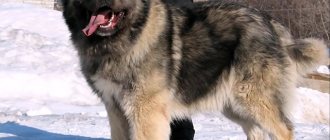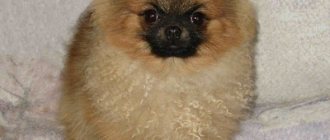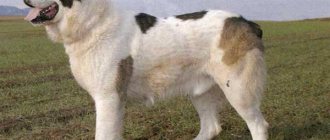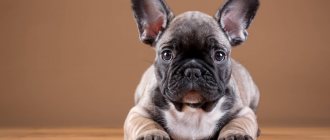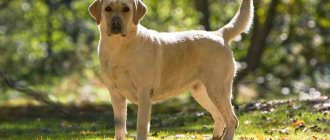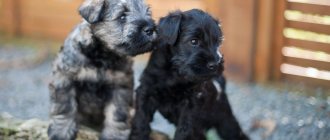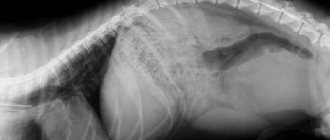Large dark eyes, a wide forehead, long paws, a muscular body, as well as a ringing voice and endurance - all these and not only characteristics distinguish hound dogs. These qualities are definitely inherent in the pride of Russian dog breeding - the Russian hound.
- 2 Table: description of the breed according to the RKF standard
2.1 Photo gallery: Russian hound standard
- 3.1 Training
Main characteristics
| Breed parameters | |
| Country of origin: | Russia |
| Weight of the breed: | male - 25-35 kg, female - 22-30 kg |
| Height at withers: | male - 57-68 cm, female - 54-65 cm |
| Temperament: | calm |
| Wool: | short |
| Role in human life: | companion, hunting |
The Russian Hound is a large dog with a strong build and bone structure. Designed for hunting in open areas. In its manner of lowering its head it resembles a wolf. Hardy, productive, completely devoted to hunting.
Average life expectancy for boys and girls
On average, dachshunds live 12-14 years. Moreover, their life expectancy does not depend too much on the gender of the dog. However, there is an opinion that female dogs live longer because they are less susceptible to stress and hormonal surges. Girls are indeed more balanced, calm and do not get into fights with other dogs as often than boys of the same breed.
If we are talking about a hunting dachshund, which often has to engage in fights with animals, then this advantage no longer plays such a big role. In this case, a girl of this breed may also be at risk of serious injury. In addition, bitches can develop serious genital diseases such as pyometra or cancer. They can also greatly shorten their lifespan.
If a dachshund does not have genetic pathologies, it did not suffer from serious infections at an early age and it does not have acquired chronic diseases, with proper care it has a good chance of living to 18-20 years.
Origin story
The first mentions of the breed date back to the 11th century, however, the real dawn of hounds began much later. In the 15th century, the fashion for hunting with dogs came. Noble nobles sought to follow it and got a large number of fast animals. At that time, hounds were called yappers because of their constant loud barking. There is an opinion that Russian racing originated from Medelyanka, now non-existent. Medelyanka is an ancient Russian breed, distinguished by its particularly large size. Its main purpose was baiting game and hunting wild animals.
The fashion for hunting hounds led to the uncontrolled mating of all animals that had at least some connection to hunting, which significantly affected the appearance and character. The research works of that time are so contradictory that it is not possible to form a single image. There is an opinion that all hunting dogs with a similar character, but completely different appearance, were called Russian hounds.
Closer to the 19th century, the situation changed somewhat, animals acquired their own “face”, and the first standard appeared. At the beginning of the 20th century, the popularization of Russians was eclipsed by the British, as hunters considered them more productive and hardy. A new trend in hound hunting gave impetus to the emergence of a completely new breed - the Russian piebald hound. Quite often these two breeds are confused, since they are very similar in appearance, the only difference being the color and vocal notes.
The Russian hound is especially popular in the territory of modern Russia and the former Soviet Union. It is not particularly in demand in European countries, since they have many of their own hunters who are more suitable in terms of climatic conditions and characteristics of the territory.
Average price of a purebred puppy
All Russian hound puppies, depending on their individual characteristics and special distinctive features, are divided into 3 classes:
- Pet is great. These puppies are not suitable for participation in exhibitions - their appearance does not meet the standards. The price of a puppy is about 6 thousand rubles.
- Brid is great. Dogs with good pedigree and no flaws in appearance, however, are not capable of winning competitions. Price from 12 to 30 thousand rubles.
- The show is great. Perfect standard hounds that win shows. The price of such a puppy is about 50 thousand rubles.
The most famous nurseries of Russian hounds are the Altaisky Hunting Dog Kennel (Russia) and the Zvonkaya Roshcha Kennel of Russian Hounds (Belarus).
Before purchasing a puppy, weigh the pros and cons carefully. If you can provide your dog with proper care and attention, it will become not just a friend, but a devoted family member. The Russian Hound is ideal for you if you are looking for an active, lively hunting dog.
Additionally, check out a short video about the Russian Hound breed:
Description of the breed
The Russian hound is a favorite breed of hunters. They have gained great popularity among outdoor enthusiasts due to their sonorous voice, extreme endurance and ability to pursue prey for a long time. Hounds are indispensable when hunting foxes, hares and even wolves.
Having attacked the trail of a wild animal, these dogs will pursue their prey at maximum speed, while their barking will be heard even in remote corners of the forest. They are so desperate that they can even chase bears and wild boars. A distinctive feature of representatives of this breed is excessive anger towards game, a complete lack of fear, good eyesight, a keen sense of smell and tirelessness. These are unsurpassed hunters and pursuers; they can help their master without respite.
Life expectancy of purebred dogs
According to veterinary experts, there is a clear relationship between the breed and the years measured to the animal. It has been scientifically proven that the smaller the dog, the longer its life.
The vitality of representatives of different breeds differs. In most cases, this is due to human selection activities. In pursuit of certain standards, dogs develop and consolidate certain characteristics, most often unnatural.
Breeding a breed is fraught with complications, which are expressed in hereditary diseases:
- Chihuahua. These cute little creatures are genetically prone to medial luxation of the kneecaps, elbow joints, and various dysplasias.
- Dachshund. Natural hunters, with a funny long body on short legs, pay with health for such a body structure. Hereditary pathology in dachshunds is intervertebral disc disease.
- Shar-Pei. Not only in this breed of dog, but also in all pets with skin folds, the disease entropion, which is essentially an entropion of the eyelid, is common.
- Rottweilers. Strong, brave, fearless and smart. But they are also susceptible to hereditary diseases - aortic stenosis, Rottweiler leukoencephalopathy, follicular lipidosis.
- Pikines. This ancient breed is distinguished by a special eye structure, for which it suffers from a tendency to eversion of the eyelids and corneal ulcers.
And each breed has its own Achilles heel - dogs with flat faces have problems with the respiratory system, with skin without fur - they often get sick, large pets are often diagnosed with diseases of the joints and bones.
In addition, breeders allow for various situations that affect the life expectancy of dogs:
- inbreeding;
- exclusion of the factor of natural selection;
- often the appearance of the offspring becomes a priority rather than health;
- The lifespan of the offspring's grandparents is not taken into account.
Based on the foregoing, we can conclude that dogs of breeds that are less susceptible to selection changes, are of medium size and without features of appearance live the longest. These include terriers, shepherds, and huskies.
The presence of long-livers in the family is of great importance. If the pet's parents lived to a ripe old age, then it also has every chance of a long life.
If we talk about numbers, on average, our four-legged friends live about 12 years. Here are some data on their life expectancy:
- , Newfoundland – from 6 to 7 years;
- , – from 7 to 8 years;
- , Rottweilers, – from 9 to 11 years;
- , West Siberian - from 10 to 14 years;
- pit bulls live on average up to 13 years;
,
There is a widespread belief that dogs of the “noble” breed live longer than their non-pedigreed counterparts. However, this is not the case. The main advantage of mestizos is the natural selection that is present in their lives. In its process, various physiological pathologies are rejected. It's all about the goal of natural selection - healthy individuals of reproductive age. The weak, sick and old have no place in this system, this is how the species survives.
So, the average age of a mongrel ranges from 9 to 12 years, but cases have been recorded when mongrel dogs lived up to 20 years. This is primarily due to good care and nutrition.
But not every yard pet receives such an honor - to live in warmth and comfort. That's why he's a servant. And this opens up a lot of opportunities for the animal to eat anything found in garbage dumps, come into contact with various, often infectious relatives, sleep on bare ground in the open air, losing health due to natural selection. Uncontrolled walking often leads to injuries to the animal, which is not always taken to a veterinary clinic. With this lifestyle, it is rare for any mongrel to live to see deep gray hairs.
Character and temperament
The Russian Hound is a hard worker with a very strong character. Despite their agility and passion for tracking down prey, these animals are relatively calm and clearly distinguish between home and work. For example, on a hunt they are an impatient assistant, ready at any second to go to great lengths, while at home they become calm and balanced pets who are difficult to anger and provoke into active emotion. Such pets can be safely left at home with children.
The only people with whom Russian hounds cannot find a common language are cats. They also do not particularly welcome small dogs and other domestic animals. Like any hunters, they see small animals as potential prey and will pursue them like game in the forest.
Hounds are not used as watchdogs, as their main purpose is stalking, not intimidation. They will certainly bark at the intruder, but you won’t get more from your pet. However, if you remember the size of the breed, then even the most sluggish attack can be quite effective. The only thing such an animal will devote itself to without reserve is hunting; everything else will simply be ignored.
Well-known dog experts define the breed as psychologically stable. This is a true friend, a devoted protector and a faithful companion. Pets sincerely become attached to their owner and cannot easily tolerate separation; they become irreplaceable and invaluable assistants in hunting activities.
They treat children well, take part in their pranks with pleasure and react tolerably to babies with their uncontrolled actions. They are not aggressive, they know how to keep emotions under control.
Education and training
Until the age of five months, the puppy is raised and taught commands independently. From five months, the dog begins to be taught to wear a collar, accustomed to a leash and walking nearby so that the puppy does not pull or shy away from side to side. From the very moment a dog appears in the house, it is taught to use the toilet outside. If you take a grown-up individual, a professional dog handler specializing in training hunting dogs should be involved in the training process.
Russian hounds are reluctant to follow the training process , but when it comes to professional skills, dogs here learn quickly and with pleasure. From ten months of age, hounds are trained for field hunting.
Before field training, dogs must be fully socialized so that they are not afraid of loud trumpets, cars or people. Therefore, from the age of six months, at the time of feeding, the puppy is accustomed to the sounds of a hunting horn, so that the dog is not afraid of sharp sounds and goes to the owner for a handout, as soon as he hears the call signs of the horns.
Maintenance and care
Based on the historical past, the best option for housing a hunting dog is a wooden booth, insulated from the outside. You can use regular hay or dry leaves as bedding. Naturally, if the dog was purchased as a pet, then the option with a kennel is completely unsuitable, especially if it will live in an apartment. In this case, you should take care of the sun lounger in advance and allocate your own corner for your four-legged friend.
If you live in the private sector, then it is best to build a spacious enclosure or a special shed with access to the street. The minimum size of the enclosure for one adult animal is 300 x 300 cm.
You need to walk your pet often, at least three times a day. Walking in crowded places is recommended with a muzzle, since Russian hunters often perceive small animals as prey and begin to hunt. The leash should be long, but adjustable.
Nutrition
Russian racing dogs absolutely calmly eat everything that their owner is ready to offer them. They never ask and will not run after you with hungry eyes. The dog lives quietly on a mono diet and accepts variety well. For example, the same greyhound will rattle its bowl and notify everyone around that it is hungry, and the hound will calmly wait for lunch.
The basic diet of a hunting dog should consist of proteins, fats, proper carbohydrates, and a vitamin and mineral complex. Consequently, the main component is meat and meat and bone products. Fats can be obtained from salmon oil, beef fat and even sour cream. Porridges (buckwheat, rice, oatmeal, corn) are used as carbohydrates. Vegetables and fruits (seasonal and seedless) are also added to the diet.
You can also feed your pet with special industrial food, only super-premium class. Give as much as recommended by the manufacturer; fresh water should always be nearby.
Long-lived dogs
Despite statistics and calculations, nature never ceases to amaze, and the Guinness Book of Records confirms this. On its pages there is data about long-lived dogs that have outlived their required age by more than twice:
- The first record-breaking pet was the Austrian shepherd, whose lifespan was more than 29 years. All his life the dog guarded sheep flocks and was active until his last days.
- Today's long-lived terrier Max is approaching his 30th birthday. By the way, the dog never received any special care and ate regular food.
The length of a dog's life is individual, but every dog owner can make it long, happy and colorful!
Diseases
The health of a pet directly depends on the conditions of detention and nutrition, as well as on the pedigree. Any experiments and incorrect matings lead to deterioration in health. Therefore, before purchasing, it is important to look at the documents and tests of parents.
If we talk about common diseases of Russian runners, these include:
- Degenerative myelopathy.
- Dysplasia.
- Allergic reaction to anesthesia.
- Myositis.
- Conjunctivitis.
What factors influence the longevity of dogs?
Just like in humans, a number of specific factors influence the lifespan of dogs:
- physical development;
- whether the animal performs loads appropriate to its age and breed;
- complete rest;
- enriched with useful substances;
- sufficient communication and attention.
All these quality indicators of life depend 100% on the owner. And the way he takes care of his dog shapes the animal’s resistance to various diseases.
A balanced diet from birth lays the foundation for the pet’s physical health for the rest of its life and even into old age. An older dog should be fed soft food to avoid problems with teeth and swallowing.
In old age, animals can suffer from various ailments, most often deteriorating hearing and vision, and disruptions in the urinary system.
Another problem that can significantly reduce the age of any animal, including dogs, is excess weight. Its excess has a detrimental effect on the health of your pet, affecting the cardiovascular system and bone structure. It is necessary to control the weight of the animal, especially in old age.
Regular medical examinations, vaccinations and timely contacting a veterinary clinic in case of any problems are what will keep your dog in good shape. Constant care for your pet throughout its life can significantly increase its life cycle.
How to choose a puppy?
To make the right choice and get a real Russian hound, you need to thoroughly prepare for the purchase. First of all, find out as much as possible about the parents of the future pet, look at exhibition diplomas, check for tests for congenital pathologies (if any are inherent in the breed).
Try to get the most well-fed and active puppy in the litter. For hunting, gender does not matter much; if you plan to engage in breeding, then you should choose the fastest of the girls. It is not recommended to make a choice based on a photo. Only the characteristics of each individual puppy, its description and nicknames can be written.
If you are afraid of making the wrong choice, then make the purchase as an adult. Then you won’t have to train the dog yourself and teach it everything. The cost of an animal depends on the purpose of purchase and varies from one hundred to a thousand dollars.
Advantages and disadvantages
Russian hounds are a specific breed of dog. These are hardy animals, endowed with a keen sense of smell, ingenuity and a high degree of malice. They have an expressive and quite musical voice, which makes them different from other hunting breeds.
The Gonchak is not a dog for everyone. It is strongly not recommended for a person who is unfamiliar with the education of hunters, and especially for someone who is getting a dog for the first time, to purchase it.
Only an experienced dog breeder, who has repeatedly encountered raising dogs of hound breeds, can properly raise a pet.


